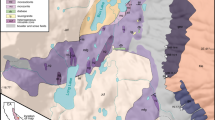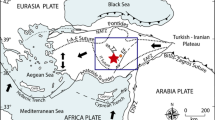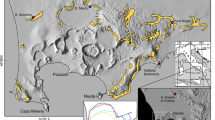Abstract
A growing body of evidence suggests the interaction between arc magmas and crustal carbonates may play a large role in outgassed CO2 at arcs. We examine magma–carbonate interactions within the shallow (< 0.2 GPa) crust in the Jurassic Bonanza arc on Vancouver Island, a well-exposed island arc crustal section. Detailed mapping in the Merry Widow mountain area revealed unique, late-stage orbicular mafic dikes that only occur above the stratigraphic level of subsurface carbonates. The orbicular dikes are primitive, show physical and chemical evidence of interaction with limestone, including high CaO/SiO2 and low REE (~ 10–20× chondrite) that correlate with orbicule abundance, and are geochemically discordant from other rocks of the Bonanza arc. The orbicules have identical intergranular textures to the host melt but markedly higher Ca/Si. Simple binary mixing and MELTS modeling indicates the orbicular dike compositions are a mixture of a primitive hydrous arc basalt with 3–25% limestone addition. Comparisons to published experimental data on basalt–calcite reaction suggest some of the dike compositions result from > 25% calcite assimilation, producing up to 11 wt% CO2, orders of magnitude higher than the CO2 solubility of the parent melt (0.11 wt% CO2). We interpret the orbicules as Ca-rich hybrid melts produced from limestone assimilation that did not homogenize with the host dike magma and underwent crystallization during rapid ascent, possibly propelled by the excess CO2. Our results inform on the amount and mechanism of CO2 transport at low crustal pressures (< 0.5 GPa) in island arcs built on carbonate platforms. We estimate the CO2 flux of the Jurassic Bonanza arc to have ranged from 0.14 to > 1.16 Tg CO2/year during its ~ 34 Myr lifespan.













Similar content being viewed by others
Data availability
Available in paper and electronic supplementary materials.
References
Andrew A, Armstrong RL, Runkle D (1991) Neodymium–strontium–lead isotope study of Vancouver Island igneous rocks. Can J Earth Sci 28:1744–1752. https://doi.org/10.1139/e91-156
Auippa A, Fischer TP, Plank T, Robidoux P, Di Napoli R (2017) Along-arc, inter-arc and arc-to-arc variations in volcanic gas CO2/ST ratios reveal dual source of carbon in arc volcanism. Earth Sci Rev 168:24–47. https://doi.org/10.1016/j.earscirev.2017.03.005
Auippa A, Fischer TP, Plank T, Bani P (2019) CO2 flux emissions from the Earth’s most actively degassing volcanoes, 2005–2015. Sci Rep 9:1–19. https://doi.org/10.1038/s41598-019-41901-y
Barnes CG, Prestvik T, Barnes MAW, Anthony EY, Allen CM (2003) Geology of a magma transfer zone: the Hortavær Igneous Complex, north-central Norway. Nor J Geol 83:187–208
Barnes CG, Prestivik T, Sundvoll B, Surratt D (2005) Pervasive assimilation of carbonate and silicate rocks in the Hortavær igneous complex, north-central Norway. Lithos 80:179–199. https://doi.org/10.1016/j.lithos.2003.11.002
Blythe LS, Deegan FM, Freda C, Jolis EM, Masotta M, Misiti V, Taddeucci J, Troll VR (2015) CO2 bubble generation and migration during magma–carbonate interaction. Contrib Mineral Petrol 169:42. https://doi.org/10.1007/s00410-015-1137-4
British Columbia Geological Survey (2021) MapPlace GIS internet mapping systems. British Columbia Ministry of Energy, Mines and Petroleum Resources. http://www.MapPlace.ca. Accessed 31 May 2021
Brooker RA, Kjarsgaard BA (2011) Silicate–carbonate liquid immiscibility and phase relations in the system SiO2–Na2O–Al2O3–CaO–CO2 at 0.1–2.5 GPa with applications to carbonatite genesis. J Petrol 52:1281–1305. https://doi.org/10.1093/petrology/egq081
Busby C, Fackler-Adams B, Mattison J, Deoreo S (2006) View of an intact oceanic arc, from surficial to mesozonal levels: Cretaceouos Alisitos Arc, Baja California. J Volcanol Geotherm Res 149:1–46. https://doi.org/10.1016/j.jvolgeores.2005.06.009
Canil D, Styan J, Larocque J, Bonnet E, Kyba J (2010) Thickness and composition of the Bonanza arc crustal section, Vancouver Island, Canada. Geol Soc Am Bull 122:1094–1105. https://doi.org/10.1130/B26578.1
Canil D, Johnston ST, Larocque JP, Friedman R, Heaman L (2013) Age, construction and exhumation of intermediate mid-crust of the Jurassic Bonanza arc, Vancouver Island, Canada. Lithosphere 5:92–97. https://doi.org/10.1130/L225.1
Cao W, Lee CTA, Lackey JS (2017) Episodic nature of continental arc activity since 750 Ma: a global compilation. Earth Planet Sci Lett 461:85–95. https://doi.org/10.1016/j.epsl.2016.12.044
Caricchi L, Sheldrake TE, Blundy J (2018) Modulation of magmatic processes by CO2 flushing. Earth Planet Sci Lett 491:160–171. https://doi.org/10.1016/j.epsl.2018.03.042
Carter LB, Dasgupta R (2015) Hydrous basalt–limestone interaction at crustal conditions: implications for generation of ultracalcic melts and outflux of CO2 at volcanic arcs. Earth Planet Sci Lett 427:202–214. https://doi.org/10.1016/j.epsl.2015.06.053
Chadwick JP et al (2007) Carbonate assimilation at Merapi volcano, Java, Indonesia: Insights from crystal isotope stratigraphy. J Petrol 48:1793–1812. https://doi.org/10.1093/petrology/egm038
Charlier B, Grove TL (2012) Experiments on liquid immiscibility along tholeiitic liquid lines of descent. Contrib Mineral Petrol 164:27–44. https://doi.org/10.1007/s00410-012-0723-y
D’Souza RJ, Canil D, Creaser R (2016) Assimilation, differentiation, and thickening during the formation of arc crust in space and time: the Jurassic Bonanza arc, Vancouver Island, Canada. Geol Soc Am Bull 128:543–557. https://doi.org/10.1130/B31289.1
DeBari SM, Anderson RG, Mortensen JK (1999) Correlation among lower to upper crustal components in an island arc: the Jurassic Bonanza arc, Vancouver Island, Canada. Can J Earth Sci 36:1371–1413. https://doi.org/10.1139/e99-029
Deegan FM et al (2010) Magma–carbonate interaction processes and associated CO2 release at Merapi volcano, Indonesia: insights from experimental petrology. J Petrol 51:1027–1051. https://doi.org/10.1093/petrology/egq010
Deegan F, Whitehouse M, Troll V, Geiger H, Jeon H et al (2021) Sunda arc mantle source delta O-18 value revealed by intracrystal isotope analysis. Nature Commun. https://doi.org/10.1038/s41467-021-24143-3
Del Moro A, Fulignati P, Marianelli P, Sbrana A (2001) Magma contamination by direct wall rock interaction: constraints from xenoliths from the walls of a carbonate-hosted magma chamber (Vesuvius 1944 eruption). J Volcanol Geotherm Res 112:15–24. https://doi.org/10.1016/s0377-0273(01)00231-1
Edmonds M, Tutolo B, Iacovino K, Moussallam Y (2020) Magmatic carbon outgassing and uptake of CO2 by alkaline waters. Am Mineral 105:28–34. https://doi.org/10.2138/am-2020-6986CCBY
Eggins SM et al (1997) A simple method for the precise determination of ≥ 40 trace elements in geological samples by ICPMS using enriched isotope internal standardisation. Chem Geol 134:311–326. https://doi.org/10.1016/S0009-2541(96)00100-3
Fecova K (2009) Conuma River and Leagh Creek intrusive complexes: windows into mid-crustal levels of the Jurassic Bonanza arc, Vancouver Island, British Columbia. M.Sc. Thesis, Simon Fraser University
Freda C, Gaeta M, Misiti V, Mollo S, Dolfi D, Scarlato P (2008) Magma–carbonate interaction: an experimental study on ultrapotassic rocks from Alban Hills (Central Italy). Lithos 101:397–415. https://doi.org/10.1016/j.lithos.2007.08.008
Fulignati P, Marianelli P, Santacroce R, Sbrana A (2004) Probing the Vesuvius magma chamber-host rock interface through xenoliths. Geol Mag 141:417–428. https://doi.org/10.1017/s0016756804009392
Ghiorso MS, Gualda GAR (2015) An H2O–CO2 mixed fluid saturation model compatible with rhyolite-MELTS. Contrib Mineral Petrol 169:1–30. https://doi.org/10.1007/s00410-015-1141-8
Giordano D, Russell JK, Dingwell DB (2008) Viscosity of magmatic liquids: a model. ESPL 271:123–134. https://doi.org/10.1016/j.epsl.2008.03.038
Heinonen JS, Iles KA, Heinonen A, Fred R, Virtanen VJ, Bohrson WA, Spera FJ (2021) From binary mixing to magma chamber simulator-Geochemical modeling of assimilation in magmatic systems. Geophys Monogr Ser (Chapter 7). https://doi.org/10.1002/9781119564485.ch7
Iacono-Marziano G, Gaillard F, Pichavant M (2007) Limestone assimilation and the origin of CO2 emissions at the Alban Hills (Central Italy): constraints from experimental petrology. J Volcanol Geotherm 166:91–105. https://doi.org/10.1016/j.jvolgeores.2007.07.001
Iacono-Marziano G, Gaillard F, Pichavant M (2008) Limestone assimilation by basaltic magmas: an experimental re-assessment and application to Italian volcanoes. Contrib Mineral Petrol 155:719–738. https://doi.org/10.1007/s00410-007-0267-8
Isson TT et al (2020) Evolution of the global carbon cycle and climate regulation on Earth. Global Biogeochem Cycles 34:1–28. https://doi.org/10.1029/2018GB006061
Kuniyoshi S, Liou JG (1976) Burial metamorphism of the Karmutsen volcanic rocks, northeastern Vancouver Island, British Columbia. Am J Sci 276:1096–1119. https://doi.org/10.2475/ajs.276.9.1096
Larocque J (2008) The role of amphibole in the evolution of arc magmas and crust: the case from the Jurassic Bonanza arc section, Vancouver Island, Canada. M.Sc. thesis, University of Victoria
Larocque J, Canil D (2010) The role of amphibole in the evolution of arc magmas and crust: the case from the Jurassic Bonanza Arc section, Vancouver Island, Canada. Contrib Mineral Petrol 159:475–488. https://doi.org/10.1007/s00410-009-0436-z
Lee CTA, Lackey JS (2015) Global continental arc flare-ups and their relation to long-term greenhouse conditions. Elements 11:125–130. https://doi.org/10.2113/gselements.11.2.125
Lee CTA et al (2013) Continental arc – island arc fluctuations, growth of crustal carbonates, and long-term climate change. Geosphere 9:21–36. https://doi.org/10.1130/GES00822.1
Lester GW, Clark AH, Kyser TK, Naslund HR (2013) Experiments on liquid immiscibility in silicate melts with H2O, P, S, F, and Cl: implications for natural magmas. Contrib Mineral Petrol 166:329–349. https://doi.org/10.1007/s00410-013-0878-1
Lund JC (1966) Structural geology of Empire Mine, Empire Development Limited, Port McNeil, British Columbia. MSc thesis, University of British Columbia
Mason E, Edmonds M, Turchyn AV (2017) Remobilization of crustal carbon may dominate volcanic arc emissions. Science 357:290–294. https://doi.org/10.1126/science.aan5049
Massey NWD (1995a) Geology and mineral resources of the Alberni-Nanaimo lakes sheet, Vancouver Island 92F/1W, 92F/2E, and part of 92F/7E. British Columbia Ministry of Energy, Mines and Petroleum Resources, Paper 1992-2, pp 1–132
Massey NWD (1995b) Geology and mineral resources of the Cowichan Lake sheet, Vancouver Island 92C/16. British Columbia Ministry of Energy, Mines and Petroleum Resources, Paper 1992-3, pp 1–112
Massey NWD (1995c) Geology and mineral resources of the Duncan sheet, Vancouver Island 92B/13. British Columbia Ministry of Energy, Mines and Petroleum Resources, Paper 1992-4, pp 1–112
McCarthy A, Müntener O (2016) Comb layering monitors decompressing and fractionating hydrous mafic magmas in subvolcanic plumbing systems (Fisher Lake, Sierra Nevada, USA). J Geophys Res Solid Earth 121:8595–8621. https://doi.org/10.1002/2016JB013489
Mollo S, Gaeta M, Freda C, Di Rocco T, Misiti V, Scarlato P (2010) Carbonate assimilation in magmas: a reappraisal based on experimental petrology. Lithos 114:503–514. https://doi.org/10.1016/j.lithos.2009.10.013
Morris R, Canil D (2020) Skarn mineralization along magma–carbonate contacts in the Merry Widow Mountain area, Vancouver Island, British Columbia (NTS 092L). In: Geoscience BC Summary of Activities 2019: Minerals, Geoscience BC, Report 2020-01, pp 5–12
Morris R, Canil D (2021) Cryptic magmatic skarn of the Merry Widow deposit, Vancouver Island (NTS 092L). In: Geoscience BC Summary of Activities: Minerals, Geoscience BC, Report 2021-01, pp 47–54
Muller JE (1977) Evolution of the Pacific Margin, Vancouver Island, and adjacent regions. Can J Earth Sci 14:2062–2085. https://doi.org/10.1139/e77-176
Nicholls J, Russell JK (2016) Igneous Rock Associations 20. Pearce element ratio diagrams: linking geochemical data to magmatic processes. Geosci Can 43(2):133–146. https://doi.org/10.12789/geocanj.2016.43.095
Nixon GT, Orr AJ (2007) Recent revisions to the early Mesozoic stratigraphy of Vancouver Island and metallogenic implications. British Columbia: British Columbia Ministry of Energy, Mines and Petroleum Resources Geological Fieldwork 2006, pp 163–177
Nixon GT et al (2011) Geology, geochronology, lithogeochemistry and metamorphism of the Alice Lake area, northern Vancouver Island, NTS 092L/06 and part of 092L/03. BC Geological Survey Geoscience Map 2011-4, vol 1, p 50000
Pearce TH (1968) A contribution to the theory of variation diagrams. Contrib Mineral Petrol 19:142–157. https://doi.org/10.1007/BF00635485
Pearce JA, Peate DW (1995) Tectonic implications of the composition of volcanic arc magmas. Annu Rev Earth Planet Sci 23:251–286. https://doi.org/10.1146/annurev.ea.23.050195.001343
Philpotts AR (1982) Compositions of immiscible liquids in volcanic rocks. Contrib Mineral Petrol 80:201–218. https://doi.org/10.1007/BF00371350
Piochi M, Ayuso RA, Vivo BD, Somma R (2006) Crustal contamination and crystal entrapment during polybaric magma evolution at Mt. Somma-Vesuvius volcano, Italy: geochemical and Sr isotope evidence. Lithos 86:303–329. https://doi.org/10.1016/j.lithos.2005.05.009
Ramos EJ, Lackey JS, Barnes JD, Fulton AA (2020) Remnants and rates of metamorphic decarbonation in continental arc. GSA Today 30:1–8. https://doi.org/10.1130/GSATG432A.1
Ratschbacher BC, Paterson SR, Fischer TP (2019) Spatial and depth-dependent variations in magma volume addition and addition rates to continental arcs: application to global CO2 fluxes since 750 Ma. Geochem Geophys Geosyst 20:2997–3018. https://doi.org/10.1029/2018gc008031
Ray GE, Webster ICL (1991) Geology and mineral occurrences of the Merry Widow skarn camp, northern Vancouver Island. BC Ministry of Energy, Mines and Petroleum Resources, BC Geological Survey, Open File 1991-08, scale 1, p 5000
Roedder E (1951) Low-temperature liquid immiscibility in the system K2O-FeO-Al2O3-SiO2. Am J Sci 35:282–286
Ryan WBF et al (2009) Global multi-resolution topography (GMRT) synthesis data set. Geochem Geophys Geosyst 10:Q03014. https://doi.org/10.1029/2008GC002332
Sangster DF (1964) The contact metasomatic magnetite deposits of southwestern British Columbia. Dissertation, University of British Columbia
Schindelin J et al (2012) Fiji: an open-source platform for biological image-analysis. Nat Methods 9:676–682. https://doi.org/10.1038/nmeth.2019
Spera FJ, Bohrson WA (2002) Energy-constrained open-system magmatic processes 3. Energy-constrained recharge, assimilation, and fractional crystallization (EC-RAFC). Geochem Geophys Geosyst 3:1–20. https://doi.org/10.1029/2002GC000315
Stewart RJ, Page RJ (1973) Zeolite facies metamorphism of the Late Cretaceous Nanaimo Group, Vancouver Island and Gulf Islands, British Columbia. Can J Earth Sci 11:280–284
Troll VR et al (2013) Magmatic differentiation processes at Merapi Volcano: inclusion petrology and oxygen isotopes. J Volcanol Geotherm Res 261:38–49. https://doi.org/10.1016/j.jvolgeores.2012.11.001
Wallace PJ (2005) Volatiles in subduction zone magmas: concentrations and fluxes based on melt inclusion and volcanic gas data. J Volcanol Geotherm Res 140:217–240. https://doi.org/10.1016/j.jvolgeores.2004.07.023
Whitley S et al (2019) Crustal CO2 contribution to subduction zone degassing recorded through calc-silicate xenoliths in arc lavas. Sci Rep. https://doi.org/10.1038/s41598-019-44929-2
Whitley S et al (2020) Magmatic and metasomatic effects of magma–carbonate interaction recorded in calc-silicate xenoliths from Merapi volcano (Indonesia). J Petrol. https://doi.org/10.1093/petrology/egaa048
Wong K, Mason E, Brune S, East M, Edmonds E, Zahirovic S (2019) Deep carbon cycling over the past 200 million years: a review of fluxes in different tectonic settings. Front Earth Sci. https://doi.org/10.3389/feart.2019.00263
Zhang J, Lee CTA (2021) Disequilibrium crystallization and rapid crystal growth: a case study of orbicular granitoids of magmatic origin. Int Geol Rev 63:900–916. https://doi.org/10.1080/00206814.2020.1734975
Zhang Y, Ni H, Chen Y (2010) Diffusion data in silicate melts. Rev Mineral Geochem 72:311–408
Acknowledgements
We thank G. Iacono-Marziano and anonymous for their constructive reviews. We also thank O. Müntener for additional comments and editorial handling of the paper. Analytical work for this project was made possible with the assistance from J. Spence at the University of Victoria, and A. Locock at the University of Alberta. We are grateful to S. Wing for his field assistance. Funding for this work was supported by a NSERC of Canada Discovery Grant 154275 (DC), Geoscience BC Scholarships (RM), and the Mineralogical Association of Canada (RM).
Author information
Authors and Affiliations
Corresponding author
Ethics declarations
Conflict of interest
The authors declare that they have no conflict of interest.
Consent to participate
Yes.
Consent to publish
Yes.
Additional information
Communicated by Othmar Müntener.
Publisher's Note
Springer Nature remains neutral with regard to jurisdictional claims in published maps and institutional affiliations.
Supplementary Information
Below is the link to the electronic supplementary material.
410_2021_1852_MOESM1_ESM.pdf
Supplementary file1. Figure 1 Ductile folding of limestone at Merry Widow occurs on a cm- and m-scale at when in close proximity with magma contacts (i.e., pluton, dikes, sills). a Folding is evident in graphite-rich layers. Photo taken near dike outcrop RM19-78 with a field book for scale. b Ductile flow of limestone around a boudinaged mafic sill. Photo taken near outcrop RM19-161. The map board for scale is 20 cm wide (PDF 239 kb)
410_2021_1852_MOESM2_ESM.pdf
Supplementary file2. Figure 2 Field photos showing orbicular dikes in outcrop, with light coloured orbicules set in a darker groundmass of host melt. Note the amalgamation of some orbicules. Photos taken at outcrop RM19-120, pen for scale (PDF 175 kb)
410_2021_1852_MOESM3_ESM.pdf
Supplementary file3. Figure 3 Field relationships of the late-stage orbicular dikes cross-cutting earlier mafic dikes and monzonite of the Merry Widow pluton (PDF 547 kb)
410_2021_1852_MOESM4_ESM.pdf
Supplementary file4. Figure 4 Pearce element ratio diagrams of plagioclase-phyric dikes (black circles) and orbicular dikes (red and yellow circles) using K (a) and Nb (b) as normalizing elements. A slope of ~ 1 for dikes indicates that the melts were dominantly controlled by olivine + clinopyroxene + plagioclase ‘sorting’ (addition and/or fractionation). This also indicates these elements were immobile on the scale of the samples. The disposition of orbicular dikes from a slope of ~ 1 when normalized to K and Nb indicates the orbicular dikes are part of a separate chemical system with different petrogenetic processes (i.e., crustal assimilation) than closed-system olivine + clinopyroxene + plagioclase addition and/or fractionation (PDF 79 kb)
410_2021_1852_MOESM5_ESM.pdf
Supplementary file5. Figure 5 Compositions of orbicule dike margins, interiors, host melt, and orbicules, as well as plagioclase-phyric dikes compared to two-liquid fields (solvi) in the systems a SiO2/4 − CaO − Al2O3 (Charlier and Grove 2012) and b FeO + MnO + TiO2 + CaO + P2O5 − Al2O3 − MgO − K2O − Na2O–SiO2 (Roedder 1951; Philpotts 1982). Note all compositions plot within the one-liquid field when compared with experimentally derived two-liquid solvi (PDF 289 kb)
Rights and permissions
About this article
Cite this article
Morris, R., Canil, D. CO2 transport at shallow depths in arc magmas: evidence from unique orbicular dikes in the Jurassic Bonanza arc, Vancouver Island, Canada. Contrib Mineral Petrol 177, 6 (2022). https://doi.org/10.1007/s00410-021-01852-y
Received:
Accepted:
Published:
DOI: https://doi.org/10.1007/s00410-021-01852-y




